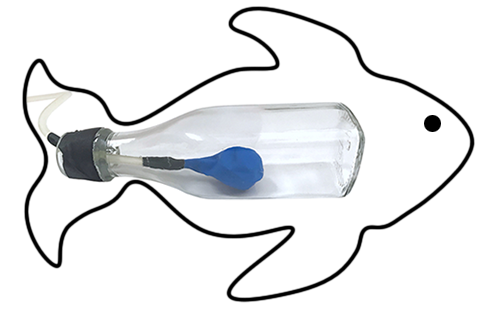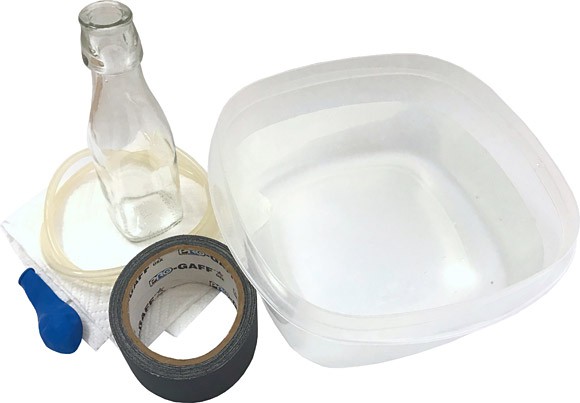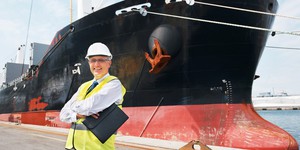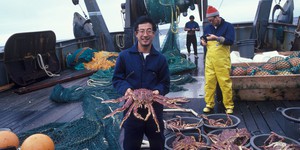Summary

Introduction
Have you ever thought about why most fish never sink to the bottom of the ocean or float to the water's surface? How is it that they can stay so perfectly buoyant under water? You might be surprised to hear that most bony fish have a special organ to help them with that: a swim bladder. The swim bladder is a thin-walled sac located inside the body of the fish that is usually filled with gas. Besides helping the fish stay buoyant, it can also function as a sound producer and receptor or as an accessory respiratory organ. Wonder how a swim bladder works? Then do this activity to find out!
Materials
- Small glass bottle
- Balloon that fits inside the bottle
- Plastic tubing (at least 30 cm or 12 inches)
- Big tub or container, waterproof and preferably transparent. It should have enough room so the glass bottle can float in it freely.
- Strong and waterproof tape
- Water
- (Paper) towels
 Image Credit: Svenja Lohner, Science Buddies / Science Buddies
Image Credit: Svenja Lohner, Science Buddies / Science Buddies
Prep Work
- Find a workspace that can tolerate water spills.
- Push one end of the tube through the opening of the balloon and tape the balloon and the tube together. After that, you should be able to inflate the balloon by blowing through the tube. Make sure the connection between the balloon and tube is airtight.
- Put the balloon inside the glass bottle and tape the tube to the bottle opening.
 Image Credit: Svenja Lohner, Science Buddies / Science Buddies
Image Credit: Svenja Lohner, Science Buddies / Science Buddies
- Fill a big tub with water.
Instructions
- Place the bottle with the balloon inside into the tub of water. Keep the other end of the tube outside of the tub.What happens when you place the bottle into the water? Does it float or sink?
- Carefully blow through the tube so the balloon inside the bottle inflates a little bit.Does inflating the balloon a little bit change the floating behavior of the bottle?
- Inflate the balloon even more until it almost fills the whole bottle.What happens as you inflate the balloon more and more?
 Image Credit: Svenja Lohner, Science Buddies / Science Buddies
Image Credit: Svenja Lohner, Science Buddies / Science Buddies
- Next, let the balloon deflate again.How does that change the position of the bottle in the water?
- Play around with inflating and deflating the balloon inside the bottle, and observe what the bottle is doing.
Cleanup
- Detach the tubing from the bottle and the balloon and dry all water spills and materials off with a towel or paper towels.
What Happened?
Can you see how what you built resembles a fish? The glass bottle mimics the body of the fish, while the balloon represents the swim bladder inside the fish's body. When you put the bottle into the tub, it should have filled with water and sank to the bottom. This is because the weight of the glass bottle filled with water is larger than the buoyancy force pushing the bottle up. This changes when you inflate the balloon. When the balloon expands, it pushes the water out of the bottle. You now have an air-filled balloon inside the bottle. As air is much lighter than the water, the bottle is not as heavy anymore and as the balloon is filled with more air, the weight of the bottle eventually becomes smaller than the buoyancy force pushing the bottle up. At this point, the bottle will start floating upwards towards the water's surface.
When you deflate the balloon again, the reverse happens. The bottle becomes heavier again due to the water flowing back into the bottle and it starts to sink. You might have noticed that the experiment doesn't work as well with a plastic bottle. This is because plastic itself is less dense than water and tends to float, while glass is denser than water and therefore sinks.
Digging Deeper
You probably know that objects can sink or float when placed into water. In both cases, the water moves out of the way, or is displaced, to make space for the object. An ancient Greek scientist called Archimedes discovered the principle of buoyancy. In physics, buoyancy is an "upward force that pushes on an object that is immersed in a liquid." If you have ever tried to push a beach ball under water, you have felt this buoyancy force in action. The ball seems to push back up although you are pushing it down! Archimedes also discovered that the strength of the upward acting force exerted by the liquid is equal to the weight of water displaced by the object, which is known as the Archimedes principle. At the same time, the volume of the displaced water is always the same as the volume of the submerged object. This is why the water displacement method is a great way to determine the volume of an irregularly shaped object.
Whether an object sinks or floats is dependent on which force is larger: the force of gravity pulling down on the object (its weight), or the buoyancy force pushing up on the object. If the buoyancy force is larger than the weight of the object, the object will float on the water's surface. However, if the object's weight exceeds the buoyancy force, it will sink to the bottom. When the buoyancy force is exactly the same as the object's weight, then the object has neutral buoyancy and remains at its level. This means that the density of the object becomes important as well. Dense objects have a high mass and only displace a low volume of water; they have a large mass-to-volume ratio. If an object has a small mass but displaces a lot of water, it is less dense and therefore has a low mass-to-volume ratio. Objects that are denser than water will sink, whereas objects that are less dense than water will float.
What does all this have to do with a swim bladder? For a fish to be buoyant, or float, it must displace an equal or lesser amount of water than its own body mass. The trick is that the swim bladder, which is basically like a balloon filled with air, can expand and contract depending on how much gas is inside. When the swim bladder expands, it will increase in volume and therefore displace more water. This increases the fish's buoyancy and it will float upwards. When the swim bladder is deflated, the fish will sink as it is displacing less water and its buoyancy decreases. Divers use the same concept for their buoyancy control devices.
Ask an Expert
For Further Exploration
- Try simulating different sizes of fish by using different types of bottles or balloons. Do all of them give you the same results? What if you put a tiny balloon in a very big bottle, or vice versa?
- Does the experiment also work with a plastic bottle instead of a glass bottle? Why or why not? Test it to find out!












